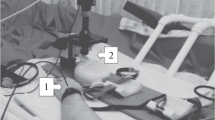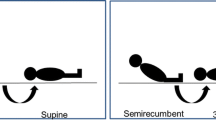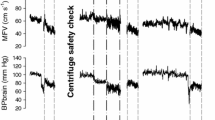Abstract
Purpose
We hypothesized that lower body microvessels are particularly challenged during exposure to gravity and hypergravity leading to failure of resistance vessels to withstand excessive transmural pressure during hypergravitation and gravitation-dependent microvascular blood pooling.
Methods
Using a short-arm human centrifuge (SAHC), 12 subjects were exposed to +1Gz, +2Gz and +1Gz, all at foot level, for 4 min each. Laser Doppler imaging and near-infrared spectroscopy were used to measure skin perfusion and tissue haemoglobin concentrations, respectively.
Results
Pretibial skin perfusion decreased by 19 % during +1Gz and remained at this level during +2Gz. In the dilated area, skin perfusion increased by 24 and 35 % during +1Gz and +2Gz, respectively. In the upper arm, oxygenated haemoglobin (Hb) decreased, while deoxy Hb increased with little change in total Hb. In the calf muscle, O2Hb and deoxy Hb increased, resulting in total Hb increase by 7.5 ± 1.4 and 26.6 ± 2.6 µmol/L at +1Gz and +2Gz, respectively. The dynamics of Hb increase suggests a fast and a slow component.
Conclusion
Despite transmural pressures well beyond the upper myogenic control limit, intact lower body resistance vessels withstand these pressures up to +2Gz, suggesting that myogenic control may contribute only little to increased vascular resistance. The fast component of increasing total Hb indicates microvascular blood pooling contributing to soft tissue capacitance. Future research will have to address possible alterations of these acute adaptations to gravity after deconditioning by exposure to micro-g.



Similar content being viewed by others
References
Adami A, Pizzinelli P, Bringard A, Capelli C, Malacarne M, Lucini D, Simunic B, Pisot R, Ferretti G (2013) Cardiovascular re-adjustments and baroreflex response during clinical reambulation procedure at the end of 35-day bed rest in humans. Appl Physiol Nutr Metab 38:673–680
Arbeille P, Kerbeci P, Mattar L, Shoemaker JK, Hughson RL (2008) WISE-2005: tibial and gastrocnemius vein and calf tissue response to LBNP after a 60-day bed rest with and without countermeasures. J Appl Physiol (1985) 104:938–943
Arbeille P, Shoemaker K, Kerbeci P, Schneider S, Hargens A, Hughson R (2012) Aortic, cerebral and lower limb arterial and venous response to orthostatic stress after a 60-day bedrest. Eur J Appl Physiol 112:277–284
Binzoni T, Quaresima V, Ferrari M, Hiltbrand E, Cerretelli P (2000) Human calf microvascular compliance measured by near-infrared spectroscopy. J Appl Physiol (1985) 88:369–372
Bonjour J, Bringard A, Antonutto G, Capelli C, Linnarsson D, Pendergast DR, Ferretti G (2011) Effects of acceleration in the Gz axis on human cardiopulmonary responses to exercise. Eur J Appl Physiol 111:2907–2917
Bonnin P, Ben DA, Benessiano J, Maillet A, le Pavy TA, Levy BI (2001) Enhanced flow-dependent vasodilatation after bed rest, a possible mechanism for orthostatic intolerance in humans. Eur J Appl Physiol 85:420–426
Bullivant M (1978) Autoregulation of plasma flow in the isolated perfused rat kidney. J Physiol 280:141–153
Capri A, Kerbeci P, Pascaud L, Arbeille P (2004) Assessment of the calf vein cross section change during stand-test after a 90 day bed rest by echography. J Gravit Physiol 11:83–84
Convertino VA (1998) High sustained +Gz acceleration: physiological adaptation to high-G tolerance. J Gravit Physiol 5:51–54
Cornelissen AJ, Dankelman J, VanBavel E, Stassen HG, Spaan JA (2000) Myogenic reactivity and resistance distribution in the coronary arterial tree: a model study. Am J Physiol Heart Circ Physiol 278:H1490–H1499
Fritsch-Yelle JM, Charles JB, Jones MM, Beightol LA, Eckberg DL (1994) Spaceflight alters autonomic regulation of arterial pressure in humans. J Appl Physiol (1985) 77:1776–1783
Fritsch-Yelle JM, Whitson PA, Bondar RL, Brown TE (1996) Subnormal norepinephrine release relates to presyncope in astronauts after spaceflight. J Appl Physiol (1985) 81:2134–2141
Fu Q, Verheyden B, Wieling W, Levine BD (2012) Cardiac output and sympathetic vasoconstrictor responses during upright tilt to presyncope in healthy humans. J Physiol 590:1839–1848
Ganzeboom KS, Colman N, Reitsma JB, Shen WK, Wieling W (2003) Prevalence and triggers of syncope in medical students. Am J Cardiol 91(1006–8):A8
Groothuis JT, Rongen GA, Geurts AC, Smits P, Hopman MT (2010) Effect of different sympathetic stimuli-autonomic dysreflexia and head-up tilt-on leg vascular resistance in spinal cord injury. Arch Phys Med Rehabil 91:1930–1935
Groothuis JT, Esselink RA, Seeger JP, van Aalst MJ, Hopman MT, Bloem BR (2011a) Lower vascular tone and larger plasma volume in Parkinson’s disease with orthostatic hypotension. J Appl Physiol (1985) 111:443–448
Groothuis JT, Thijssen DH, Lenders JW, Deinum J, Hopman MT (2011b) Leg vasoconstriction during head-up tilt in patients with autonomic failure is not abolished. J Appl Physiol (1985) 110:416–422
Kamiya A, Michikami D, Fu Q, Iwase S, Mano T (1999) Sympathetic vasoconstriction and orthostatic intolerance after simulated microgravity. J Gravit Physiol 6:101–102
Kamiya A, Iwase S, Sugiyama Y, Mano T, Sudoh M (2000) Vasomotor sympathetic nerve activity in men during bed rest and on orthostasis after bed rest. Aviat Space Environ Med 71:142–149
Kamiya A, Michikami D, Iwase S, Hayano J, Kawada T, Sugimachi M, Sunagawa K (2004) Alpha-adrenergic vascular responsiveness to sympathetic nerve activity is intact after head-down bed rest in humans. Am J Physiol Regul Integr Comp Physiol 286:R151–R157
Kerbeci P, Shoemaker K, Hughson R, Roncin A, Arbeille P (2007) Tibial and gastrocnemian vein response to LBNP after a 60 day bedrest with and without counter-measures (WISE study). J Gravit Physiol 14:57–58
Lalande S, Buick F (2009) Physiologic +Gz tolerance responses over successive +Gz exposures in simulated air combat maneuvers. Aviat Space Environ Med 80:1032–1038
Maillet A, Fagette S, Allevard AM, Pavy-Le TA, Guell A, Gharib C, Gauquelin G (1996) Cardiovascular and hormonal response during a 4-week head-down tilt with and without exercise and LBNP countermeasures. J Gravit Physiol 3:37–48
Millet C, Custaud MA, Maillet A, Allevard AM, Duvareille M, Gauquelin-Koch G, Gharib C, Fortrat JO (2001) Endocrine responses to 7 days of head-down bed rest and orthostatic tests in men and women. Clin Physiol 21:172–183
Moyses C, Cederholm-Williams SA, Michel CC (1987) Haemoconcentration and accumulation of white cells in the feet during venous stasis. Int J Microcirc Clin Exp 5:311–320
Newman DG, Callister R (2008) Cardiovascular training effects in fighter pilots induced by occupational high G exposure. Aviat Space Environ Med 79:774–778
Newman DG, White SW, Callister R (1998) Evidence of baroreflex adaptation to repetitive +Gz in fighter pilots. Aviat Space Environ Med 69:446–451
Robertson D, Convertino VA, Vernikos J (1994) The sympathetic nervous system and the physiologic consequences of spaceflight: a hypothesis. Am J Med Sci 308:126–132
Serletis A, Rose S, Sheldon AG, Sheldon RS (2006) Vasovagal syncope in medical students and their first-degree relatives. Eur Heart J 27:1965–1970
Sevilla NL, Gardner JW (2005) G-induced loss of consciousness: case-control study of 78 G-Locs in the F-15, F-16, and A-10. Aviat Space Environ Med 76:370–374
Shoemaker JK, Hogeman CS, Sinoway LI (1999) Contributions of MSNA and stroke volume to orthostatic intolerance following bed rest. Am J Physiol 277:R1084–R1090
Shoemaker JK, Hogeman CS, Sinoway LI (2003) Sympathetic responses to Valsalva’s manoeuvre following bed rest. Can J Appl Physiol 28:342–355
Siitonen SL, Kauppinen T, Leino TK, Vanninen E, Kuronen P, Lansimies E (2003) Cerebral blood flow during acceleration in flight measured with SPECT. Aviat Space Environ Med 74:201–206
Strandgaard S, MacKenzie ET, Sengupta D, Rowan JO, Lassen NA, Harper AM (1974) Upper limit of autoregulation of cerebral blood flow in the baboon. Circ Res 34:435–440
Tattersall I, Matternes JH (1992) The Cambridge encyclopedia of human evolution. Cambridge University Press, New York
Uhlig S, von Bethmann AN (1997) Determination of vascular compliance, interstitial compliance, and capillary filtration coefficient in rat isolated perfused lungs. J Pharmacol Toxicol Methods 37:119–127
van Duijnhoven NT, Thijssen DH, Green DJ, Felsenberg D, Belavy DL, Hopman MT (2010) Resistive exercise versus resistive vibration exercise to counteract vascular adaptations to bed rest. J Appl Physiol (1985) 108:28–33
Verheyden B, Ector H, Aubert AE, Reybrouck T (2008) Tilt training increases the vasoconstrictor reserve in patients with neurally mediated syncope evoked by head-up tilt testing. Eur Heart J 29:1523–1530
Watenpaugh DE, Breit GA, Buckley TM, Ballard RE, Murthy G, Hargens AR (2004) Human cutaneous vascular responses to whole-body tilting, Gz centrifugation, and LBNP. J Appl Physiol (1985) 96:2153–2160
Wieser M, Gisler S, Sarabadani A, Ruest RM, Buetler L, Vallery H, Klamroth-Marganska V, Hund-Georgiadis M, Felder M, Schoenberger JL, Gutknecht C, Riener R (2014) Cardiovascular control and stabilization via inclination and mobilization during bed rest. Med Biol Eng Comput 52:53–64
Acknowledgments
The study was sponsored by a Grant (50WB1123) from Bundesministerium für Wirtschaft und Technologie via Deutsches Zentrum für Luft- und Raumfahrt (German Aerospace Center).
Author information
Authors and Affiliations
Corresponding author
Ethics declarations
Conflict of interest
The authors report no conflict of interest.
Additional information
Communicated by Massimo Pagani.
Rights and permissions
About this article
Cite this article
Habazettl, H., Stahn, A., Nitsche, A. et al. Microvascular responses to (hyper-)gravitational stress by short-arm human centrifuge: arteriolar vasoconstriction and venous pooling. Eur J Appl Physiol 116, 57–65 (2016). https://doi.org/10.1007/s00421-015-3241-6
Received:
Accepted:
Published:
Issue Date:
DOI: https://doi.org/10.1007/s00421-015-3241-6




